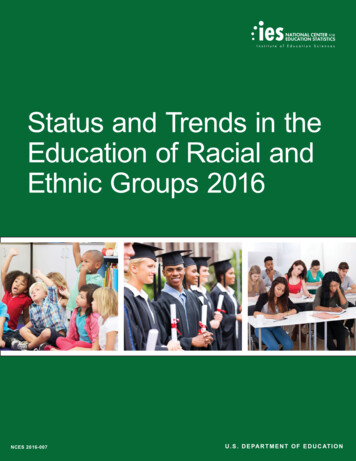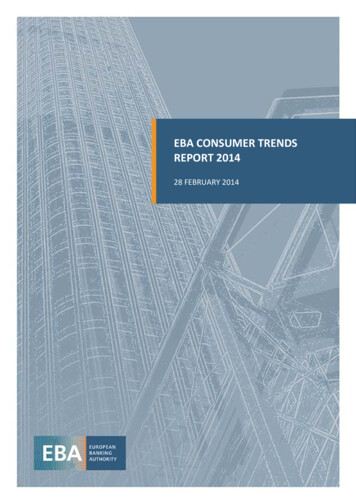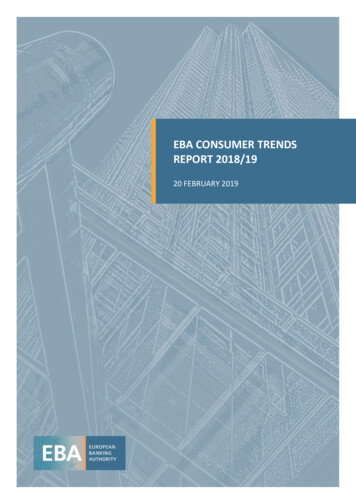
Transcription
Status and Trends in theEducation of Racial andEthnic Groups 2016NCES 2016-007U . S . D E PA R T M E N T O F E D U C AT I O N
Status and Trends in theEducation of Racial andEthnic Groups 2016AUGUST 2016Lauren Musu-GilletteJennifer RobinsonJoel McFarlandNational Center for Education StatisticsAngelina KewalRamaniAnlan ZhangSidney Wilkinson-FlickerAmerican Institutes for ResearchNCES 2016-007U. S . D E PA R T M E N T O F E D U CAT I O N
U.S. Department of EducationJohn B. King, Jr.SecretaryInstitute of Education SciencesRuth NeildDeputy Director for Policy and ResearchDelegated Duties of the DirectorNational Center for Education StatisticsPeggy G. CarrActing CommissionerThe National Center for Education Statistics (NCES) is the primary federal entity for collecting, analyzing, andreporting data related to education in the United States and other nations. It fulfills a congressional mandate to collect,collate, analyze, and report full and complete statistics on the condition of education in the United States; conductand publish reports and specialized analyses of the meaning and significance of such statistics; assist state and localeducation agencies in improving their statistical systems; and review and report on education activities in foreigncountries.NCES activities are designed to address high-priority education data needs; provide consistent, reliable, complete,and accurate indicators of education status and trends; and report timely, useful, and high-quality data to the U.S.Department of Education, the Congress, the states, other education policymakers, practitioners, data users, and thegeneral public. Unless specifically noted all information contained herein is in the public domain.We strive to make our products available in a variety of formats and in language that is appropriate to a variety ofaudiences. You, as our customer, are the best judge of our success in communicating information effectively. If you haveany comments or suggestions about this or any other NCES product or report, we would like to hear from you. Pleasedirect your comments toNCES, IES, U.S. Department of EducationPotomac Center Plaza (PCP)550 12th Street SWWashington, DC 20202August 2016The NCES Home Page address is http://nces.ed.gov.The NCES Publications and Products address is http://nces.ed.gov/pubsearch.This publication is only available online. To download, view, and print the report as a PDF file, go to the NCESPublications and Products address shown above.This report was prepared for the National Center for Education Statistics under Contract No. ED-IES-12-D-0002with American Institutes for Research. Mention of trade names, commercial products, or organizations does not implyendorsement by the U.S. Government.Suggested CitationMusu-Gillette, L., Robinson, J., McFarland, J., KewalRamani, A., Zhang, A., and Wilkinson-Flicker, S. (2016). Statusand Trends in the Education of Racial and Ethnic Groups 2016 (NCES 2016-007). U.S. Department of Education,National Center for Education Statistics. Washington, DC. Retrieved [date] from http://nces.ed.gov/pubsearch.Content ContactLauren Musu-Gillette(202) 245-7045lauren.musu-gillette@ed.gov
HighlightsStatus and Trends in the Education of Racial and Ethnic Groups examines the educational progress and challengesstudents face in the United States by race/ethnicity. This report shows that over time, students in the racial/ethnicgroups of White, Black, Hispanic, Asian, Native Hawaiian or Other Pacific Islander, American Indian/Alaska Native,and Two or more races have completed high school and continued their education in college in increasing numbers.Despite these gains, the rate of progress has varied among these racial/ethnic groups and differences by race/ethnicitypersist in terms of increases in attainment and progress on key indicators of educational performance.Demographics: The percentage of school-age children ages 5–17 inthe United States who were White decreased from62 percent in 2000 to 53 percent in 2013, and thepercentage of children who were Black decreasedfrom 15 to 14 percent during this time. In contrast,the percentage of school-age children who were fromother racial/ethnic groups increased during thisperiod: those who were Hispanic increased from16 to 24 percent; those who were Asian, from 3 to5 percent; and those who were of Two or more races,from 2 to 4 percent. (Indicator 1).In 2013, the percentage of all U.S. children under18 who were born within the United States was97 percent. The percentages of Asian, Pacific Islander,and Hispanic children who were born within theUnited States (79, 93, and 94 percent, respectively)were below the 97 percent average for all children.In contrast, the percentages of Black children(97.5 percent), White children and children of Two ormore races (99 percent each), and American Indian/Alaska Native children (rounds to 100 percent) whowere born within the United States were above theaverage for all children. (Indicator 2). Greater percentages of Asian and Hispanic childrenunder 18 were born within the United States in 2013than in 2003 (79 vs. 77 percent for Asian childrenand 94 vs. 89 percent for Hispanic children).(Indicator 2). In 2013, a higher percentage of Asian children(83 percent) lived with married parents than didWhite children (73 percent), Pacific Islander children(60 percent), Hispanic children and children of Twoof more races (57 percent each), American Indian/Alaska Native children (44 percent), and Blackchildren (32 percent). (Indicator 3). The percentage of children under age 18 living inpoverty, based on the official poverty measure, variedacross racial/ethnic groups. In 2013, the percentagewas highest for Black children (39 percent), followedby Hispanic children (30 percent), and White andAsian children (10 percent for each). (Indicator 4).Preprimary, Elementary, and SecondaryEducation Participation: In 2012, about 28 percent of children under 6 yearsold who were not enrolled in kindergarten regularlyreceived center-based care. The percentage of childrenwho regularly received center-based care was higherfor Black (34 percent), Asian (33 percent), and Whitechildren (29 percent) than for Hispanic children(22 percent). (Indicator 5). In 2012, a higher percentage of young children fromnonpoor families than from poor families regularlyreceived center-based care (34 vs. 20 percent). Thissame pattern was observed for White, Black, andHispanic young children. (Indicator 5). Between fall 2002 and fall 2012, the percentage ofstudents enrolled in public elementary and secondaryschools who were White decreased from 59 to51 percent, and the percentage who were Blackdecreased from 17 to 16 percent. During the sameperiod, however, the percentage who were Hispanicincreased from 18 to 24 percent, and the percentagewho were Asian/Pacific Islander increased from 4 to5 percent. (Indicator 6 ). Black students accounted for a higher percentageof enrollment in public charter schools (28 percent)than in traditional public schools (15 percent) in2012. Hispanic students also accounted for a higherpercentage of enrollment in public charter schools(29 percent) than in traditional public schools(24 percent). The percentage of public charter schoolenrollees who were White (35 percent) was lower thanthe percentage of traditional public school enrolleeswho were White (52 percent). Asian/Pacific Islanderstudents also made up a lower percentage of charterschool enrollees (4 percent) than of traditional publicschool enrollees (5 percent). (Indicator 6 ). In 2013, about 4.6 million public school studentsparticipated in English language learner (ELL)programs. Hispanic students made up the majorityof this group (78 percent), with around 3.6 millionparticipating in ELL programs. (Indicator 7).Highlightsiii
The ELL program participation rate in 2013 forsome racial/ethnic groups was lower than the totalparticipation rate (9 percent). About 7 percent ofAmerican Indian/Alaska Native students, 2 percent ofBlack students, 2 percent of students of Two or moreraces, and 1 percent of White students participatedin ELL programs. In contrast, the percentages ofHispanic (29 percent), Asian (20 percent), and PacificIslander (14 percent) students participating in ELLprograms were higher than the total percentage in2013. (Indicator 7).In 2012–13, the percentage of students served underthe Individuals with Disabilities Education Act(IDEA) was highest for American Indian/AlaskaNative students (16 percent), followed by Blackstudents (15 percent), White students (13 percent),students of Two or more races (13 percent), Hispanicstudents (12 percent), Pacific Islander students(11 percent), and Asian students (6 percent).(Indicator 8).month preceding data collection was higher for Asianstudents (65 percent) than for students who wereBlack (46 percent), Hispanic (44 percent), White(43 percent), of Two or more races (42 percent),American Indian/Alaska Native (36 percent), orPacific Islander (35 percent). (Indicator 11). A higher percentage of Asian students (45 percent)than of students of any other racial/ethnic groupearned their highest math course credit in calculus.The percentage earning their highest math coursecredit in calculus was also higher for White students(18 percent) than for students of Two or more races(11 percent), Hispanic students (10 percent), andBlack students (6 percent). (Indicator 12). The percentage of students who were 9th-graders infall 2009 earning any Advanced Placement/International Baccalaureate (AP/IB) credits by 2013was higher for Asian students (72 percent) thanfor White students (40 percent). The percentagesfor Asian and White students were higher than thepercentages for students of any other racial/ethnicgroup. (Indicator 13). The average number of AP/IB course credits earned inhigh school by Asian students (4.5 credits) was higherthan the average earned by students of any otherracial/ethnic group. Additionally, White studentsearned a higher number of total AP/IB credits in highschool (3.1 credits) than Black students (2.7 credits).(Indicator 13).Achievement: At grade 4, the White-Black gap in reading narrowedfrom 32 points in 1992 to 26 points in 2013; theWhite-Hispanic gap in 2013 (25 points) was notmeasurably different from the gap in 1992. Atgrade 8, the White-Hispanic gap narrowed from26 points in 1992 to 21 points in 2013; the WhiteBlack gap in 2013 (26 points) was not measurablydifferent from the gap in 1992. (Indicator 9). At grade 12, the White-Black achievement gap inreading was larger in 2013 (30 points) than in 1992(24 points), while the White-Hispanic readingachievement gap in 2013 (22 points) was notmeasurably different from the gap in 1992.(Indicator 9). At grade 4, the White-Black achievement gap inmathematics narrowed from 32 points in 1990 to26 points in 2013; there was no measurable differencebetween the 1990 and 2013 White-Hispanic gaps.(Indicator 10). At grade 8, there was no measurable difference inthe White-Black or White-Hispanic mathematicsachievement gaps between 1990 and 2013.(Indicator 10). The mathematics scores for White 12th-graderswere higher than the scores for their Black andHispanic peers in 2005, 2009, and 2013. There wereno measurable changes in White-Black and WhiteHispanic mathematics achievement gaps at grade 12between any of these years. (Indicator 10). ivIn 2013, the percentage of 8th-graders who reportedthat they had zero absences from school in theStudent Behaviors and Persistence: The percentage of students retained in grade between1994 and 2014 decreased for those who were Black(from 4.5 to 3.0 percent), as well as for those whowere White (from 2.5 to 2.0 percent). There was nomeasurable difference between the 1994 and 2014percentages of Hispanic students retained in grade.(Indicator 14). In 2012, the percentage of Black male students whohad ever been suspended from school (48.3 percent)was more than twice the percentage of Hispanic(22.6 percent), White (21.4 percent), and Asian/Pacific Islander (11.2 percent) male students who hadever been suspended. Similarly, the percentage ofBlack female students who had ever been suspended(29.0 percent) was more than twice the percentageof Hispanic (11.8 percent), White (9.4 percent), andAsian/Pacific Islander (7.9 percent) female studentswho had ever been suspended. (Indicator 14). In 2013, the percentage of students in grades 9–12who reported being threatened or injured with aweapon on school property during the previous12 months was higher for American Indian/AlaskaNative (18 percent) and Hispanic students (8 percent)Status and Trends in the Education of Racial and Ethnic Groups 2016
than for White (6 percent) and Asian students(5 percent). The percentage was also higher for Blackstudents (8 percent) than for White students.(Indicator 15). From 1990 to 2013, the Hispanic status dropout rateamong 16- to 24-year-olds decreased from 32 to12 percent, while the Black rate decreased from13 to 7 percent and the White rate decreased from9 to 5 percent. Nevertheless, the Hispanic statusdropout rate in 2013 remained higher than the Blackand White status dropout rates. (Indicator 16 ). Among Hispanic subgroups, the high schoolstatus dropout rate for 16- to 24-year-olds in 2013ranged from 2 percent for Peruvians to 27 percentfor Guatemalans. Among Asian subgroups, statusdropout rates ranged from 1 percent for Koreans to37 percent for Bhutanese. (Indicator 16 ). From 1990 to 2013, the high school status completionrate for Hispanic 18- to 24-year-olds increased from59 percent to 85 percent, while the Black and Whitestatus completion rates increased from 83 percentto 92 percent and from 90 percent to 94 percent,respectively. Although the White-Hispanic andWhite-Black gaps in status completion rates for 18- to24-year-olds narrowed between 1990 and 2013, the2013 status completion rates for Hispanic and Blackindividuals remained lower than the White rate.(Indicator 17).Postsecondary Education: The 2013 total college enrollment rate for White18- to 24-year-olds (42 percent) was higher than therates for their Black and Hispanic peers (34 percenteach). The White-Hispanic gap in the total collegeenrollment rate narrowed between 2003 and 2013(from 18 to 8 percentage points); however, the WhiteBlack gap in the total college enrollment rate did notchange measurably during this period. (Indicator 18).Among Hispanic subgroups, the total collegeenrollment rate in 2013 ranged from 25 percentfor Guatemalan young adults to 62 percent forVenezuelan young adults. Among Asian subgroups,the total college enrollment rate ranged from20 percent for Bhutanese young adults to 84 percentfor Other Southeast Asian (i.e., Indonesian andMalaysian) young adults. (Indicator 18).Between 1990 and 2013, total fall undergraduateenrollment of some racial/ethnic groups grew fasterthan that of other groups, and the racial/ethnicdistribution of students therefore changed. Thelargest increases in undergraduate enrollment wereobserved for Hispanic and Black students; specifically,Hispanic student enrollment as a percentage of totalenrollment increased 11 percentage points (from6 to 17 percent) and Black student enrollment as apercentage of total enrollment increased 5 percentagepoints (from 10 to 15 percent) during this timeperiod. (Indicator 19). Among undergraduate students in 2013, about83 percent of Hispanic students, 81 percent of Asianstudents, and 79 percent of American Indian/AlaskaNative students attended public institutions, higherthan the percentages of students of Two or moreraces (77 percent), White students (76 percent), Blackstudents (70 percent), and Pacific Islander students(68 percent) who attended them. (Indicator 19). Among full-time, full-year undergraduate students,85 percent of Black and American Indian/AlaskaNative students and 80 percent of Hispanic studentsreceived any type of grants in 2011–12. Thesepercentages were higher than the percentages ofstudents of Two or more races (73 percent) and ofWhite (69 percent), Pacific Islander (67 percent),and Asian (63 percent) students who received grants.(Indicator 20). In 2011–12, about 72 percent of Black studentsreceived any type of loans, compared with 62 percentof American Indian/Alaska Native students,59 percent of students of Two or more races,56 percent of White, 51 percent of Hispanic students,51 percent of Pacific Islander students, and 38 percentof Asian students. (Indicator 20). The 2013 graduation rate was 59 percent for firsttime, full-time undergraduate students who begantheir pursuit of a bachelor’s degree at a 4-yeardegree-granting institution in fall 2007. The 6-yeargraduation rate was highest for Asian students andstudents of Two or more races (71 percent and68 percent, respectively), and lowest for Black andAmerican Indian/Alaska Native students (41 percenteach). (Indicator 21). The 3-year graduation rate for first-time, full-timestudents at public 2-year institutions in 2013 washighest for Asian students (28 percent) and lowest forBlack students (11 percent). Graduation rates for firsttime, full-time students at public 2-year institutionsin the remaining racial/ethnic groups ranged from15 to 22 percent. (Indicator 21). The number of bachelor’s degrees conferred toHispanic students more than doubled between2002–03 and 2012–13, and the number conferredto Black students increased by 54 percent. Duringthe same period, the number of degrees conferredto Asian/Pacific Islander, White, and AmericanIndian/Alaska Native students increased by smallerpercentages (48, 23, and 16 percent, respectively).(Indicator 22).Highlightsv
In 2012–13, a higher percentage of bachelor’s degreeswere conferred in the field of business than in anyother field across all racial/ethnic groups, rangingfrom 16 percent for students of Two or more races to23 percent for Pacific Islander students. (Indicator 23). In 2012–13, the percentage of STEM (science,technology, engineering, and mathematics) bachelor’sdegrees conferred to Asian students (30 percent)was almost double the average conferred to allstudents (16 percent). In contrast, the percentages ofbachelor’s degrees in STEM fields conferred to Black(11 percent), Hispanic (14 percent), American Indian/Alaska Native (14 percent), and Pacific Islanderstudents (15 percent) were lower than the averageconferred to all students. (Indicator 24). In 2013, among adults ages 25 to 64 who had notcompleted high school, lower percentages of Hispanicand Asian adults were unemployed (both 9 percent)than of White (14 percent), Black (25 percent), andAmerican Indian/Alaska Native (23 percent) adults.(Indicator 26). Among adults ages 25 to 64 with a bachelor’s orhigher degree, a lower percentage of White adults(3 percent) were unemployed in 2013 than of Asian(4 percent), Hispanic and American Indian/AlaskaNative (both 5 percent), and Black (6 percent) adults.(Indicator 26 ). Among young adults ages 20 to 24, higherpercentages of Black and American Indian/AlaskaNative young adults (29 and 38 percent, respectively)were neither enrolled in school nor working in 2014than of White (16 percent), Hispanic (21 percent),and Asian (13 percent) young adults, as well asyoung adults of Two or more races (15 percent).(Indicator 27). Among full-time workers ages 25–34 who did notcomplete high school, median annual earnings ofWhite workers ( 30,000) were higher than medianannual earnings of their Black ( 20,500) andHispanic peers ( 22,800) in 2013. (Indicator 28). In 2013, among those with a bachelor’s or higherdegree, median annual earnings of Asian full-timeworkers ages 25–34 ( 59,900) were higher thanmedian annual earnings of their White ( 50,000),Black ( 44,600), and Hispanic peers ( 45,800).(Indicator 28).Outcomes of Education: viIn 2013, the percentage of 18- to 24-year-oldswho had not completed high school was higher forAmerican Indian/Alaska Native young adults(25 percent) than for any other racial/ethnic group.Among adults age 25 and older, the percentage whohad not completed high school in 2013 was higher forHispanic adults (35 percent) than for any other racial/ethnic group. (Indicator 25).The percentage of adults age 25 and older who hadearned at least a bachelor’s degree in 2013 was highestfor Asian adults (52 percent). Of the other racial/ethnic groups, 14 percent of Hispanic adults,15 percent of American Indian/Alaska Native adults,16 percent of Pacific Islander adults, 19 percent ofBlack adults, 32 percent of adults of Two or moreraces, and 33 percent of White adults had earned atleast a bachelor’s degree. (Indicator 25).Status and Trends in the Education of Racial and Ethnic Groups 2016
ContentsHighlights. iiiList of Figures . ixList of Tables.xiiiReader’s Guide. 1Chapter 1. Demographics. 6Indicator 1. Population Distribution. 8Indicator 2. Nativity. 12Indicator 3. Children’s Living Arrangements. 16Indicator 4. Children Living in Poverty. 20Snapshot of Children Living in Poverty for Racial/Ethnic Subgroups. 24Chapter 2. Preprimary, Elementary, and Secondary Education Participation. 26Indicator 5. Early Childcare and Education Arrangements. 28Indicator 6. Elementary and Secondary Enrollment. 32Indicator 7. English Language Learners. 36Indicator 8. Children with Disabilities. 38Chapter 3. Achievement. 40Indicator 9. Reading Achievement. 42Indicator 10. Mathematics Achievement. 48Indicator 11. Absenteeism and Achievement. 52Indicator 12. High School Coursetaking. 56Indicator 13. Advanced Placement and International Baccalaureate Coursetaking. 62Chapter 4. Student Behaviors and Persistence. 64Indicator 14. Retention, Suspension, and Expulsion. 66Indicator 15. Safety at School. 70Indicator 16. High School Status Dropout Rates. 76Snapshot of High School Status Dropout Rates for Racial/Ethnic Subgroups. 80Indicator 17. High School Status Completion Rates. 82Chapter 5. Postsecondary Education. 86Indicator 18. College Participation Rates. 88Snapshot of College Participation Rates for Racial/Ethnic Subgroups. 92Indicator 19. Undergraduate and Graduate Enrollment. 96Indicator 20. Financial Aid. 104Indicator 21. Postsecondary Graduation Rates. 108Indicator 22. Degrees Awarded. 112Contentsvii
Indicator 23. Undergraduate and Graduate Degree Fields. 120Indicator 24. STEM Degrees. 126Chapter 6. Outcomes of Education. 128Indicator 25. Educational Attainment. 130Indicator 26. Unemployment Rates. 136Indicator 27. Youth Neither Enrolled in School nor Working. 140Indicator 28. Employment and Earnings. 142References. 146Appendix A. Guide to Sources. 148Appendix B. Glossary. 162viiiStatus and Trends in the Education of Racial and Ethnic Groups 2016
List of FiguresFigurePage1.1Estimates of the U.S. resident population, by age group: Selected years, 1990 through 2013. 81.2Estimates of the 5- to 17-year-old U.S. resident population, by race/ethnicity: Selected years,2000 through 2013. 91.3Percentage distribution of the U.S. resident population 5 to 17 years old, by race/ethnicity:2000 and 2013. 101.4Percentage distribution of the U.S. resident population 18 to 24 years old, by race/ethnicity:2000 and 2013. 112.1Percentage of the population born within the United States, by race/ethnicity: 2003 and 2013. 122.2Percentage of the population under 18 years old born within the United States, by race/ethnicity:2003 and 2013. 132.3Percentage of the Hispanic population born within the United States, by subgroup and age group: 2013. 142.4Percentage of the Asian population born within the United States, by subgroup and age group: 2013. 153.1Percentage distribution of children under age 18, by race/ethnicity and living arrangement: 2013. 163.2Percentage distribution of Hispanic children under age 18, by subgroup and living arrangement: 2013. 173.3Percentage distribution of Asian children under age 18, by subgroup and living arrangement: 2013. 184.1Percentage of children under age 18 in families living in poverty based on the official poverty measure,by race/ethnicity: 2000–13. 204.2Percentage of children under age 18 in families living in poverty based on the Supplemental PovertyMeasure, by race/ethnicity: 2012 and 2013. 214.3Percentage of children under age 18 in families living in poverty, by race/ethnicity and type ofpoverty measure: 2013. 224.4Percentage of children under age 18 in mother-only households living in poverty, by race/ethnicity andtype of poverty measure: 2013. 234.1aPercentage of children under age 18 living in poverty, by selected Hispanic subgroups: 2013. 244.2aPercentage o
The ELL program participation rate in 2013 for some racial/ethnic groups was lower than the total participation rate (9 percent). About 7 percent of American Indian/Alaska Native students, 2 percent of Black students, 2 percent of students of Two or more races, and 1 percent of White students participated in ELL programs.











